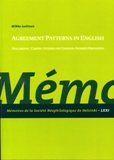|
Review of:
Laitinen, Mikko (2007), Agreement Patterns in English: Diachronic Corpus Studies on Common-Number Pronouns. Mémoires de la Société Néophilologique de Helsinki. Tome LXXI. Helsinki: Société Néophilologique

Received February 2009, published April 2009 (HSL/SHL 9)
This is Laitinen’s doctoral dissertation published in book form. Its main part consists of five independent studies (chapters VI-X), preceded by an elaborate introduction (five chapters) and followed by the overall conclusions in chapter XI. The work presents a diachronic approach to the matter of number agreement between indefinite pronouns, such as SOME(BODY), EACH/EVERY, etc. and their anaphora. Cataphoric reference in the structures HE, THEY,THOSE + THAT or WHO is also dealt with. The primary data have been drawn from the Corpus of Early English Correspondence or CEEC (1500-1800), supplemented with some other contemporary material and examples from the British National Corpus for present-day English.
I suggest that we focus on the basic chapters only. In chapter VI Laitinen is concerned with the distribution of HE vs. THEY with (indefinite) epicene or common-number antecedents. The findings are quite interesting. The use of plural anaphorics is widespread these days, which Laitinen rightly relates to “conscious efforts towards non-sexist ... language” (Laitinen 2007: 122). As in the nineteenth-century corpus investigated in Dekeyser (1975: 73-94), the choice is also register-conditioned: the plural is significantly less frequent in “literate genres” than in what Laitinen calls “imaginative” texts. There is also a striking difference between -ONE and -BODY compounds: with the former the historical singular meaning is still predominantly present, which seems to account for the frequent use of singular anaphora, as contrasted with the -BODY pronoun.
Chapter VII is concerned with the expression of human indefinite reference in Early Modern English, in both cataphoric and anaphoric contexts. Chapter VIII is entirely devoted to the change of agreement patterns of anaphora with indefinite pronouns through time, i.e. from 1500 tot 1800. The findings correspond remarkablywith my own results for the nineteenth century (Dekeyser 1975). Since the beginning of the Early Modern English period there has been an overall continuous trend towards the use of plural anaphora: “... but everye bodyes deedes and sayings should agree with theyre meanings ...” (Thomas Howard 1608, quoted in Laitinen 2007: 184). This change may well have reached its completion in present-day English, or nearly so; see Laitinen’s chapter VI. Laitinen suggests that this spread of the plural was triggered by the increasing grammaticalisation of the compound elements -ONE, -BODY and -MAN, which blurred their underlying singular meaning. However, my objection here is that most indefinites in other languages, such as Dutch, German or French, are also the output of grammaticalisation, yet this does not lead to plural anaphora. In Dutch “*Iedereen moet hun plicht doen” (“Everybody has to do their duty”) never occurs and would not be considered “correct”. The data from my work (Dekeyser 1975: 79-81) clearly demonstrate that women writers used plural anaphora considerably more often than men, which is perfectly understandable from a psychological point of view. I suggest that this is obviously connected with “gender”: since the Early Middle English period natural gender has been a typological feature of English grammar. This means that pronouns like HE, HIS, SHE, HER are virtually exclusively associated with male/female referents, while inanimates are systematically treated as “neuter”. As I see it, this hypothesis is convincingly borne out by the present-day English data referred to in my discussion of chapter VI. It is therefore surprising that the author does not bring up the matter of gender here, while he does so in the general conclusions.
Chapter IX is an interesting one in that linguistic variants are correlated with sociolinguistic variables “in order to acquire a more precise picture of language change” (Laitinen 2007: 207-208). “Sociolinguistic” is to be taken here as a very heterogeneous cover term, comprising not only gender and register, i.e. sender-addressee relations, but also regional variation. However, neither register nor regional variation proves to be a statistically significant parameter. By contrast, the gender data once again suggest the outspoken preference of women letter-writers for plural THEY etc. I thus refer to my earlier comment on the gender “gap” in the previous chapter.
Chapter X, which deals with present-day variation in the agreement patterns involved, is largely based on data analysed in the other chapters. Finally, chapter XI recapitulates the major findings of this work. One recurrent feature stands out: the steady and sweeping rise of THEY etc. with the common-gender indefinite pronouns, which the author this time does relate to the shift from grammatical to natural gender, viewed as part of “a broader typological evolution in English” (Laitinen 2007: 277). Frankly speaking, the conclusions do not disclose anything entirely new, but never before has this singular-plural shift been so thoroughly documented, while the methodological approach is fully embedded in the most recent trends and developments in linguistics.
Xavier Dekeyser, Universities of Antwerp and Leuven (contact the reviewer)
References:
Dekeyser, Xavier (1975). Number and Case Relations in 19th-Century British English. A Comparative Study of Grammar and Usage. Antwerpen/Amsterdam: De Nederlandsche Boekhandel.
|